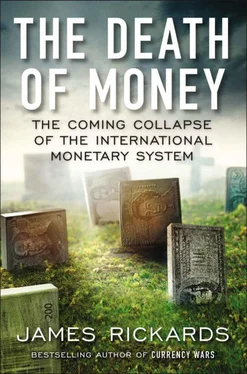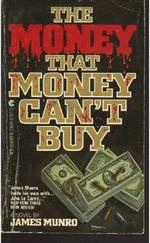U.S. investment in, 127
Eurozone, 117, 121–27, 129, 130, 135, 136
gold-to-GDP ratio of, 157, 280
exchange rates, 130
external adjustment of unit labor costs, 131
Fail-Safe (film), 63
Fannie Mae, 248
Federal Open Market Committee (FOMC), 249–52
Federal Reserve
asset bubble creation by, 75–78
bank risk taking in low-interest-rate environment created by, 80–81
central bank, status as, 198–99
central planning by, 69, 71, 87
debt and deficits, monetary policy’s relation to, 176–77, 180–89
deflation and, 9–11, 76–83
easy-money policy of (See easy-money policy of Federal Reserve)
financial repression engineered by, 183–84
financial war, views on, 60–62
FOMC member views on tapering versus money-printing, 249–52
forward guidance of, 83, 86, 185–88
gold held in vaults of, 230
Great Depression monetary policy of, 223
Greenspan’s battling of deflation and creation of housing bubble, 76
insolvency of, 286–88
irreversibility of money creation and, 290
money contract and, 167, 180–89
PDS inputs, and monetary policy, 180–83
quantitative easing (QE) programs, 184–85
real income declines resulting from policies of, 78–79
savers penalized by policies of, 79
SME lending damaged by policies of, 79–80
U.S Treasury debt purchases by, 172
wealth effect and, 72–75
zero-interest-rate policy of, 72, 73, 79–81, 185, 186, 260
Federal Reserve Bank of New York, 73–74, 230
Federal Reserve Notes, 167
Federation of American Scientists, 58
fiat money, 168–69
financial repression, 183–84
financial risk, 85, 268–70
financial transmission, 193–94
financial war, 6–7, 42–64
accidental, 63
Chinese cybercapabilities, 45–46, 51–53
CIC-Blackstone deal, 51–52
cyberattacks combined with, 59–60
defensive aspects of, 46
enemy hedge fund scenario, 47–51
equilibrium models and, 62
Federal Reserve’s view of, 60–62
MARKINT as means of detecting, 40–41
offensive aspects of, 46
panic dynamic and, 62
physical targets, 46
purpose of, 61
solutions to, 64
U.S. cybercapabilities, 53–54
U.S.-Iran, 54–58
U.S.-Syria, 57
U.S. Treasury’s view of, 60–62
virtual targets, 46
Wall Street’s cybercapabilities, 54
war games, 58–59
fine art, as investment, 299
fiscal dominance, 287–88
Fiscal Stability Treaty (EU), 135–36
Fisher, Irving, 168, 246–47
Fisker, 123
Fitzgerald, F. Scott, 252
flash crash, 63, 270, 296–97
floating-exchange-rate regime, 235
Fonda, Jane, 1
food price inflation, 3
food stamps, 246
Ford, Gerald, 271–72
forward guidance, 83, 86, 185–88
forwards, gold, 275, 285–86
France, 235, 236
Franco-Prussian War, 115
Frank, Barney, 204, 205
Frankenreich, 112, 113–14
Freakonomics (Levitt and Dubner), 32–33
Freddie Mac, 248
Friedman, Milton, 84, 168, 263
Friedman, Tom, 256
Froman, Michael, 195, 196, 202–3
futures, gold, 275, 284–86
G7, 139, 140, 147
G9, 139–40
G20, 140, 147, 202, 203
Galloni, Alessandra, 131–32
Gang of Ten, 138, 139
Geithner, Timothy, 195, 196, 203, 244
General Electric, 255
General Theory of Employment, Interest and Money, The (Keynes), 246–47
Genoa Conference, 1922, 221–22
Gensler, Gary, 195, 196
geopolitics, 12–13
Germany, 125, 127, 136–37, 281
gold repatriation by, 231–32
GIIPS (Greece, Ireland, Italy, Portugal, Spain), 140, 142–46
Glass-Steagall, repeal of, 196, 253, 296
gold, 215–42
BIS transactions, 276–78
central bank acquisition of, since 2010, 225–30
central bank manipulation of, 271–81
Charlemagne’s switch from gold to silver standard, 114
Chávez’s repatriation of, 40, 231
China’s accumulation of, 12, 61, 226–30, 282–84, 296
classical gold standard, 1870–1914, 176, 234–35
constructing new gold standard, 237–42
contract money system, role in, 169–71
contracts based on, risks associated with, 217–18
disorderly price movements, implications of, 295–96
dollar convertibility abandoned, in 1971, 1, 2, 5, 209, 220, 235, 285
dollar standard, 234–35
drop from 1980 highs, 2
forwards, 275, 285–86
futures, 275, 284–86
Germany’s repatriation of, 231–32
gold exchange standard, 221–22, 224, 234–35
gold-to-GDP ratios, 157, 279–82
Great Depression caused by gold myth, 221–24
IMF sales of, 235–36, 277
as investment portfolio recommendation, 298–99
Iranian trading of, in financial war with U.S., 55–56
lease arrangements, 275, 284
market panics caused by gold myth, 224
monetary policy, and classical gold standard, 176
monetary system, role in, 217, 220–25
as M-Subzero, 280, 283–84
nature of, 218–20
as numeraire, 219–20
price rise of, 1977 to 1980, 1
price rise of, 2006 to 2011, 3
private market demand for, 230
quantity insufficient to support world trade and finance myth, 220
repatriation of, 40, 231–34
reserves, rebalancing of, 279–84
return-to-gold-standard scenario, 293–94
as risk-free asset, 219
Russia’s accumulation of, 12, 229–30
shadow gold standard, 236
storage of, at Federal Reserve and Bank of England vaults, 230–31
swaps, 275
Switzerland’s repatriation of, 232–33
U.S. attitude to, shift in, 235, 236
Gold and Foreign Exchange Committee, 272–73
Goldberg, Jonah, 294
Gold Bloc devaluations, 222
Goldman Sachs, 32–33, 128, 139, 140, 205, 206, 262
gold-to-GDP ratios, 157, 279–82
Goodhardt, Charles, 71, 72, 87, 188
Goodhardt’s Law, 71, 87
Gotthard Base Tunnel, 123
government debt repayment, impact of deflation on, 9, 258
government program dependency, in U.S., 246
Graeber, David, 255
Grant, James, 177
Great Depression, 84, 85, 125–26, 155, 221–22, 223–24, 234, 244, 245
Greece, 128, 133–34, 142, 153, 200, 290
greed, 25
Greenspan, Alan, 76, 77, 122
gross domestic product (GDP)
of China, 93, 96
components of, 84, 96
debt-to-GDP ratio, 9, 159–60, 173, 258–59, 261
of U.S., 96, 244
Gulf Cooperation Council (GCC), 12, 150, 152–57
monetary integration process and, 153–57
as quasi-currency union, 153
Hague Congress, 116
Hall, Robert, 86–87
Hamilton, Alexander, 120–21
Han Dynasty, 90
Hanke, Steve, 80
Haydn, Michael, 37
Hayek, Friedrich, 70–71, 72, 87
hedge fund covert operations, 47–51
Hemingway, Ernest, 256
Herzegovina, 136
Himes, James, 284
Holocaust, 115
Holy Roman Empire, 114, 115
Hong Ziuquan, 91
Hoover, Herbert, 85
housing market
bubbles in, 75, 76–77, 248
collapse of, 2007, 248, 296
rise in, since 2009, 291
wealth effect and, 72, 73
HSBC, 227
Hu Jintao, 151–52, 202
Hunt, Lacy H., 74, 79
Hunt brothers, 217
Hyundai, 82
ImClone Systems, 25
income inequality, in China, 106
India, 12, 139, 151. See also BRICS (Brazil, Russia, India, China, South Africa)
IMF commitment of, 202
U.S.-Iran financial war and, 55, 57
Indonesia, 45
inflation, 3–4, 7–9, 75–83
alternative measures of, 3
Berlin Consensus and, 122–23
versus deflation, in depression of 2007 to present, 243–52, 260, 290–91
Читать дальше











